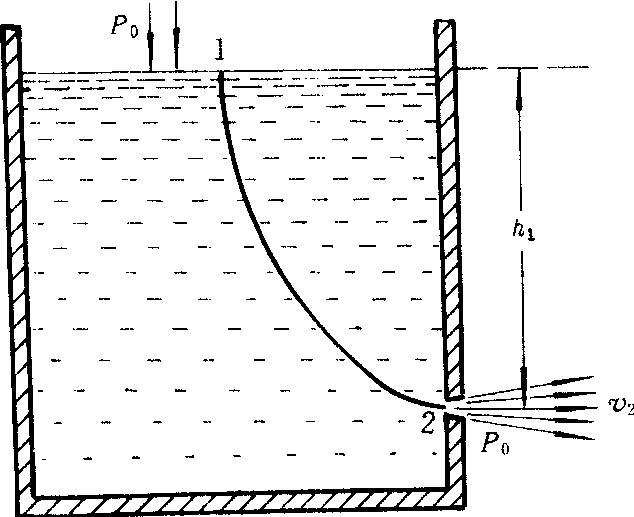伯努利方程bonuli fangcheng
流体力学的一个基本方程,理想流体做稳定流动时沿某 一流线上任 一点的压强p与速度v之间所满足的方程。即:p/ρ+gh+v2/2=H。式中H为沿流线的常数,h为流线上压强为p速度为v的点相对重力势能参考平面的高度,ρ与g分别为流体的密度和重力加速度。1738年,瑞士数学家、物理学家D·伯努利发表了《流体动力学》一书,首次提出关于理想流体定常流动的伯努利方程。该方程实质上是功能原理在流体力学中的特殊形式,它为流体动力学的创立奠定了基础。在解决具体的流动问题时,可从所选的同一条流线上取两个或三个点列出方程。由于细流管的截面很小,同一截面上各点的压强、速度和高度可近似看作相等。所以方程仍能使用。如果伯努利方程和连续性方程联合使用,则对解决流体问题更加方便。方程中的压强p不是静压强。流动流体内部的压强分布规律与静止流体的不同,只能用伯努利方程求解。对于水平流线,方程式变为p1/ρ+v21/2=p2/ρ+v22/2。它表明,流体内部,流速大的区域压强小,流速小的区域压强大。或者说,流线密集处压强小,流线稀疏处压强大。

图1
在图1中,2处的流速远大于1处,因此2处的压强比大气压p0小的多,所以容器内的液体在大气压强的作用下被源源不断地输送到2处,这叫做空吸作用。射流真空泵就是利用这种原理工作的。对小孔流速问题,如图2示,方程式变成gh1=v22/2。小孔流速为v2=
 。这意味着小孔流速与自由落体具有相同的速率。由于真实流体内部存在着内摩擦,所以实际的小孔流速要比
。这意味着小孔流速与自由落体具有相同的速率。由于真实流体内部存在着内摩擦,所以实际的小孔流速要比 小(1~2)%。
小(1~2)%。
图2
伯努利方程
又称“液体的能量方程”。是流体力学中普遍应用的公式。表达式为:

 分别为单位位置势能、单位压强势能、单位动能;三项之和即为单位机械能。伯努利方程表明,在理想液体的恒定流动中,同一条流线上各质点的单位机械总能量是守恒的。在理想液体的恒定有势流动中,任一点的单位机械总能量都是相等的。
分别为单位位置势能、单位压强势能、单位动能;三项之和即为单位机械能。伯努利方程表明,在理想液体的恒定流动中,同一条流线上各质点的单位机械总能量是守恒的。在理想液体的恒定有势流动中,任一点的单位机械总能量都是相等的。